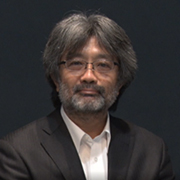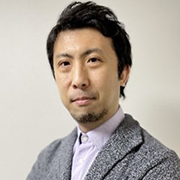Artificial intelligence (AI) and video analytics are rapidly becoming integral parts of our lives, transforming corporate activities, and creating many opportunities to improve the human condition. Recent developments in the field have led some experts to suggest that the ability of AI has moved beyond recognition to cognition, where AI is not only able to grasp concepts but find deeper or “hidden” meaning from images.
Dr. Shin'ichi Satoh of the National Institute of Informatics (NII) and Dr. Tatsuhiko Kagehiro, head of Hitachi's Lumada Data Science Laboratory, met to discuss the current state and next wave of advancements in this field and to explore the possibilities of social application. Dr. Satoh is a leading expert in video analytics research and AI that leads to customer collaborative creation, and Dr. Kagehiro is director of Hitachi's Artificial Intelligence Innovation Center, which conducts research and development. Mr. Tomoaki Yoshinaga, Senior Researcher at the Lumada Data Science Laboratory, moderated the discussion.
(Published 31 March 2021)
Tomoaki
Much progress is being made in fields such as AI and video analytics, and it is said that the capabilities of these technologies are “approaching human cognition.” How do you see the current situation?
Shin'ichi
The possibilities are continually expanding with advances in deep learning, machine learning, and AI technology. For example, in the case of video analytics, the ability to find objects and identify images is growing and is said to have already surpassed that of humans. Deep fakes are a recent example, as is the ability to create images or videos that look like the real thing, and the GPT-3 language that can produce human-like text. New applications are emerging such as self-driving cars and applications and auto-diagnosis based on medical information, and there are even devices that have received certification. I believe this trend will continue for some time.

Tatsuhiko
There have been rapid advances in image processing and image recognition. A turning point that can be called epoch-making for us was the joint creation of a video analytics system with Hitachi and Daicel Corporation in 2016. This system can collect information on worker movement and recognize and analyze frontline worker activities. This system can analyze trends and predict movements to help ensure safety in the customer workplaces, and to record manufacturing logs, for example, which was a major step forward.
Tomoaki
Now that AI has become capable of cognition, I would like to hear your views on why this is important, both from the perspective of technology and from the perspective of human needs.
Shin'ichi
From a technology standpoint, AI is coming close to matching or surpassing human capabilities. In other words, technology has been created that is able to replace human beings. Some might say, “Why not just use human beings?” But by using computers in place of humans, we gain speed and greater scale. And besides, computers don't tire out, and they remain unwavering in their judgment. When human beings get tired, their judgment can be diminished, but this is not the case with computers. Also, during a pandemic, we humans need to avoid close contact, but computers don't have this limitation; they can perform investigations even in extreme environments. These kinds of advantages — the large scale, ability to operate in harsh environments, not tiring — are extremely important in self-driving vehicles, for example, or in surveillance using security cameras. I believe they are also important points for auto-diagnosis in medical care. These are the areas where I see big advantages.
Tatsuhiko
The technologies Dr. Satoh described are also rapidly expanding at Hitachi. For uses up to now, the strongest needs were for greater efficiency and cost saving. As we work toward Society 5.0 and a human-centered society, approaches that seek to raise the quality of human life will become much more significant. Along with the advantages such as monitoring videos, reducing costs, and making things easier, today we also emphasize ensuring the safety and health of workers. We, a joint research team from NII and Hitachi achieved the highest level score at TRECVID, an international workshop/ technology competition in video retrieval. The task set was on disaster recognition and to ensure the safety of all. The number of these forward-looking uses cases that will benefit society are currently growing.
Tomoaki
Thank you. So, it's not about taking work away from people, but supporting them and improving their quality of life. If that's the case, AI will need to understand people better to better support them.
Tomoaki
As the role played by AI in our lives grows, and the burden on AI increases, I believe it will be important for it to have a sense of ethics close to that of human beings. Can you tell us about the initiatives by NII and Hitachi, and other efforts to deal with the ethics of AI?
Shin'ichi
While I am not engaged in research in ethics as an academic field, ethics is highly important to those scientists conducting research. The areas where technology can be applied keep on expanding. Naturally, this means that the applications are also growing. I believe it is extremely important for NII to consider what must be protected when technology comes to be used in a new area, and to guarantee that protection. And when there is bias in the data, it can lead to unanticipated problems like recognition errors. To make very sure such things don't happen, it will be vital that research advances so that we have explainable AI—that is, the AI side is able to explain why it made a specific decision.
Tatsuhiko
That is a key issue. At Hitachi, everyone is deeply aware of our corporate mission and works to uphold the three values of Harmony, Sincerity and the Pioneering Spirit, which form the Hitachi Founding Spirit and are part of the Hitachi Group Identity. We researchers also focus on our research by implementing these three values. The Hitachi business reaches across many technologies and many industries, extending from electric power generation to plants, railways, IT systems, consumer electronics, and more. Within all these areas, it is vital that we take on the issues of values and ethics. Right now, we are considering how best to demonstrate this stance to our stakeholders. We are thinking about how, for our part, we can communicate Hitachi's values in a way that is fitting for Hitachi and understandable to everyone.*1
Tomoaki
Thank you for that clear explanation. In your years of working in the AI field, in your research up to now, could you tell us about things you have noticed in AI studies that are of particular interest?
Tatsuhiko
Since Hitachi is, after all, a corporation, it is of utmost importance that we listen to our customers' needs and seek to develop AI that can solve their issues. And in fact, we see that solving these needs and issues leads to the emergence of new businesses and solutions.

To give a specific example, we worked with Tokyu Railways on finding ways to visually show crowding at its train stations. Image recognition lets the customer see the flow of people. But rather than simply showing them this flow, we developed new technology that replaces this part with avatars. By having discussions with the customers where they could tell us about their issues, we came to understand the actual problem and proposed solving it this way, and the customer accepted our proposal. While we anticipated that this technology would be used in various solutions, we did not expect to use this technology as preventive technology in a pandemic. utilize the technology for totally unexpected application. After the COVID-19 pandemic came along, we worked with the Yomiuri Giants baseball club on a trial for visualizing crowding so that they could help alleviate the crowding. I see this as an example of how one application can be further expanded by showing customers various results of AI applications, and having the customers decide what works.
Shin'ichi
Essentially, AI means giving the system data and having it learn from that data. The system accepts the given data straightforwardly. For example, we wanted the system to recognize automotive vehicles, so we assembled images of vehicles and worked hard to have it learn them. After some investigation, what we found is that the system had learned to detect roads. So, when shown a road, the system saw it as a car. Because a system lacks human common sense it can do quite unexpected things, so we must be really careful in our application and use of AI and learn from it too.
Tomoaki
Some people feel that, in the case of cars, consumer electronics and other products people use, a really important option would be to employ AI not just for the functions but in the design as well. In the future, could it be used for creating designs that people prefer?
Shin'ichi
This is a particularly difficult challenge. The technology supporting the creation of images, such as design images, or drawing cartoons, has come a long way. When it comes to design, however, coming up with designs that people prefer is a challenge. While it is possible to teach a system more or less the kinds of images people like, for example, by continual learning from their image selections, design in the true sense is still difficult for AI. What can be done today is more like co-creation with humans, or support through collaboration. That's about it. Using AI to create a new design from scratch is still difficult.
Tatsuhiko
I agree that it would be very difficult for AI to come up with a full-blown design on its own that the customer would like. The obstacles to this are quite high. What is possible, on the other hand, is setting up a co-creation project, and Hitachi is experimenting with this approach. In co-creation, designers and engineering researchers work together with the customer on the same project. What I found interesting in such a project is the different ideas that come up from the engineering and designer standpoints, respectively, and how surprisingly practical approaches can emerge from these ideas. This could be one possible way of doing design with AI.
Tomoaki
I see. It's important for us to understand that AI is not quite capable of coming up with a design on its own, but it can work with human beings to support design creation.
Finally, I would like to ask each of you for a word about the outlook for AI. How do you see it expanding and progressing?
Tatsuhiko
As I'm sure you are already aware, there were two major AI booms in the past, and right now we are in a third boom. With the benefit of hindsight, we can now see that in both past booms, the technology failed to meet the huge expectations of the public and the booms fizzled out. In this third boom, we will need to create technology in a form that meets expectations so that the boom does not fade. I want to make sure this third boom is not transitory. We therefore will need to provide technology that can meet and satisfy customer needs, and that contribute to society and business.
Shin'ichi
I'm in total agreement. I also feel that in this third boom we have already gone beyond a certain point, and we now have technology that can actually be used. An important aspect will be to enable this technology to be used with assurance, such as by combining explainable AI with other similar technologies. We will also need to see success in cooperation and co-creation with human beings. Sound decisions will need to be made about the timing of support by seeing what human beings do and learning from it, and by observing human behavior and understanding intentions. To raise overall productivity, a proper division will need to be made between the things human beings are best at, and the specialties of machines. I believe we have at last entered a key phase where successes in such areas are developing in meaningful ways.
AI is becoming an integral part of our lives and exploring how it can improve the human condition is an exciting phase in its development. Hitachi will continue to explore how technology can contribute to a sustainable society, providing environmental value, increasing resilience, and ensuring safety and security. Watch for our next discussion, which will discuss AI in post-COVID India.
(As at the time of publication)

Shin'ichi SATOH, Ph.D.
Professor in Digital Content and Media Sciences Research Division,
National Institute of Informatics (NII), Tokyo, Japan.
Prof. Satoh received his PhD degree in 1992 from the University of Tokyo.
His research interests include image processing, video content analysis and multimedia database. Currently he is leading the video processing project at NII, addressing video analysis, indexing, retrieval, and mining for broadcasted video archives.

Tatsuhiko KAGEHIRO, Ph.D.
General Manager of Center for Technology Innovation - Artificial Intelligence,
(concurrently) Director of Lumada Data Science Laboratory,
Research & Development Group, Hitachi, Ltd.
Kagehiro joined the Central Research Laboratory of Hitachi, Ltd. after completing his M. Eng. at Tsukuba University in 1994. As a researcher, he researched about image processing and recognition technologies for products. He was also a visiting scholar at University of Surry, from 2005 to 2006. He led the research unit of video surveillance system and media processing for industry. From 2015, in Global Center for Social Innovation, he commercialized the humanoid robot EMIEW. From 2017, head of Media Intelligent Processing department, and from April 2020, he was appointed to his current position.

Tomoaki YOSHINAGA
Senior Researcher of Lumada Data Science Laboratory,
Research & Development Group, Hitachi, Ltd.
Yoshinaga joined the Central Research Laboratory of Hitachi, Ltd. after completing his Master of Computer Science at the Tokyo Institute of Technology in 2004. As a researcher, he began his work on research in image recognition and machine learning technologies for consumer products. From 2015-2016, he was joined the research team at the R&D division of Hitachi America in Santa Clara. Since 2020, he has been leading video analytics research project for public safety.